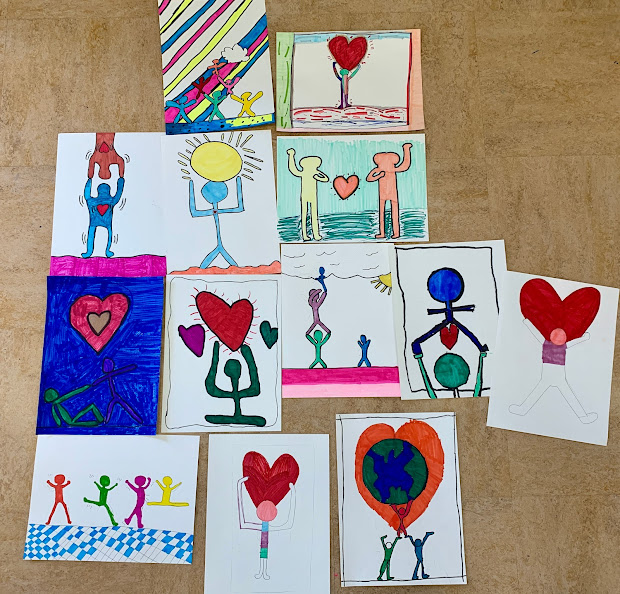December 2022 Art Blog
TK/Kindergarten
The Skin You Live In: Self Portrait
How Many Colors Are There in the Human Rainbow?
Visual arts are a wonderful, organic way to engage our students in conversation about skin colors, self love, respect for others, race and diversity. Students engaged in a self-study about their skin color and the skin of their peers, family and community. The culminating end product was a self portrait featuring student’s personal skin colors.
The book "The Skin You Live In" written by Michael Tyler, illustrated by David Lee Csicsko was a great introduction for students to share observations about their skin. After the read- aloud, students painted with watercolors creating color recipe charts to mix their own skin tones and used creative words to name and describe their skin colors. Students painted one entire page with their skin tone and wrote their creative names of their skin color on the page.
Students continued the study of their skin by contemplating the question: “How many colors are there in the human rainbow?” By artist Angélica Dass’ count, at least 4,000. Since 2012, the Brazilian artist has been photographing people of every color and matching each subject’s skin tone to hues from the Pantone printing color chart to codify a unique chromatic inventory.
Dass’s project, titled “Humanæ,” has traveled the world and is featured in National Geographic. The project focuses on the idea of race as a social construct, rather than a biological one.
Inspired by Dass’ work students drew and layered their self portraits on top of their skin color paper. Students studied basic facial proportions and facial features leaving room for personal expression and details. Students used art media of their choice such as watercolor, marker, color pencil and crayons to paint hair, eye and lip colors and wrote their creative names for their skin colors onto their self portraits.
1st grade
What Do You Love About Yourself? I Love My….inspired by Andrea Pippins
This study is a wonderful progression of the previous skin color unit. It focuses on social justice curriculum elements ‘Self Love and Knowledge’ and “Respect for Others.”
Students were introduced to Andrea Pippins, an illustrator and author who has a passion for creating images that reflect what she would like to see in art, media, and design. Her work has been featured in Essence Magazine, The New York Times, and The Oprah Magazine.
Students read Pippins’ book 'Who Will You Be' and talked about identity and goals in terms of positive characteristics. For further inspiration students watch Pippins’ video about her coloring book “I Love My Hair” and brainstormed attributes they love about themselves. As a class, we studied Pippin's work closely and identified that her style includes a limited palette of 3-4 bright bold colors, and the repetition of blocky geometric shapes such as zigzags, triangles, lightning bolts and lines.
Students drew and painted expressive self-portraits in watercolors and added the words "I love My..." to their portraits.
2nd grade
Family Portrait inspired by Todd Parr
Students were introduced to the local author and illustrator Todd Parr. He is the author and illustrator of more than 60 books for children, including the New York Times bestselling The I Love You Book, The Earth Book, and The Thankful Book. He has inspired, empowered, and entertained millions of children around the world with his bold images, unique sense of humor, and inclusive storytelling.
Students read The Family Book and shared their connections with the stories. Some families look alike, some families like to eat different things, some families like to hug each other, some families have two moms or two dads, some families are noisy, some are quiet.
Students drew their family members in a simple cartoon style like Todd Parr. Students added clues and selected colors to personalize each of their family members.
3rd grade
Say Something Poster: The World Needs Your Voice!
Student voice is at the forefront of this unit of study, tying into social justice curriculum elements 'Social Movement, Social Change’ and ‘Awareness Raising '. Students designed posters using their art and words to express their feelings about a cause that is important to them.
Our voices have power! It is important to teach students that they can use their voice to speak up about issues that are important to them.
Students dove into this artistic journey by reading the story “Say Something!” written and illustrated by Peter H. Reynolds. During class discussions we reflect on the following questions before beginning our design work:
What would you like to see change in the world?
How can your voice change the world?
Why is it important to use your voice?
How can we inspire others with our voice?
How can you use your voice to create a more just community?
For visual inspiration, students viewed a variety of posters created for Amplifier, a non-profit design lab that features art to amplify the most important movements of our time. Furthermore, students discussed the artwork “Growing Acceptance” illustrated by their very own art teacher Ms. Libby.
Students gained an understanding of how our words can turn into positive action! To help emphasize this topic we read the story “Change Sings” written by Amanda Gorman and illustrated by Loren Long. In addition students researched young activists who have used their voice to speak up for what they believe in and whose actions have created a positive change in the world.
Students recorded important facts about Haring in their sketchbooks and viewed samples of his work. Focusing on Haring's iconic imagery, students analyzed a few samples of his works and used "his clues" (color, symbols, and motion marks) to identify and guess Haring's message to the viewer.
Students sketched ideas to express a positive message or thought in a Keith Haring style. Students finalized their positive message posters carefully selected bright colors to support their message.
May you guess the message/idea/story that the students are communicating?Students embraced this design challenge with heartfelt engagement mapping out powerful compositions to make their voices for their cause visible. Students decided on design elements, color pallet, art media and technique to best support their artwork. The project illustrates how important it is to engage in critical conversations with students. This includes conversations about identity, power, privilege, and the ways that injustice affects our lives and our society.
This project is an example of how educators may lead students through these conversations so that they can begin to think about how their words and actions can create change. A helpful tool to guide conversation is the “Let’s Talk” guide created by Teaching Tolerance.
Our voices, art, and actions can change the world!
4th grade
Positive Message Poster inspired by Keith Haring
Students were introduced to the works of Pop artist Keith Haring. Haring (1958-1990) was famous in the 1980s for his often large scale art, which was a mixture of graffiti and pop art. He used bright colors and simplistic, cartoon like images, expressing his social, emotional, and political views.
Students sketched ideas to express a positive message or thought to promote love, kindness, acceptance, peace, equality etc. in a Keith Haring style. Students presented their ideas in small groups and gave each other feedback. Students used pop art techniques such as simple figures, motion lines, and bright colors to express their ideas and to communicate their views. Can you guess the students' message/idea/story they are communicating?


























Beautiful!!
ReplyDeleteThese are wonderful. Such great messaging though art!
ReplyDeleteInspiring messages -- thank you for all you do!
ReplyDeleteThis comment has been removed by the author.
ReplyDelete